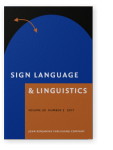On the notion of metaphor in sign languages
Some observations based on Russian Sign Language
Metaphors in sign languages have been an important research topic in recent
years, and Taub’s (2001) model of
metaphor formation in signs has been influential in the field. In this paper, we
analyze metaphors in signs of cognition and emotions in Russian Sign Language
(RSL) and argue for a modification of Taub’s
(2001) theory of metaphor. We demonstrate that metaphor formation in
RSL uses a number of mechanisms: a concrete sign can acquire metaphorical
meaning without change, a part of a sequential compound can acquire a
metaphorical meaning, and a morpheme within a productive sign or a simultaneous
compound can acquire a metaphorical meaning. All these processes have parallels
in spoken languages, so we argue for a modality-independent model of metaphor
formation where metaphorical mapping is divorced from iconicity.
Article outline
- 1.Introduction
- 1.1Metaphor as mapping
- 1.2Metaphors and iconicity in sign languages
- 1.3Current study
- 2.Methodology
- 3.Metaphorical mechanisms
- 3.1A concrete sign acquires metaphorical meaning without change
- 3.2A concrete sign acquires metaphorical meaning in a compound
- 3.3A meaningful morpheme acquires a metaphorical meaning in particular contexts
- 3.3.1Metaphors in sign language classifiers
- 3.3.2Metaphors in simultaneous compounds
- 3.4Unclear cases
- 3.4.1Lack of the source meaning
- 3.4.2Different sign forms in the source and the target meanings
- 4.Discussion
- 4.1Typology of metaphorical mechanisms
- 4.2Iconicity and metaphor
- Acknowledgements
- Notes
-
References
References
Benedicto, Elena & Diane Brentari
2004 Where did all the arguments go?: Argument-changing properties of classifiers in ASL.
Natural Language & Linguistic Theory 22(4). 743–810.


Brennan, Mary
1990 Productive morphology in British Sign Language. In
Siegmund Prillwitz &
Tomas Vollhaber (eds.),
Sign language research and application. Proceedings of the International Congress on Sign Language Research and Application, Hamburg, 205–288. Hamburg: Signum.

Brennan, Mary
2005 Conjoining word and image in British Sign Language (BSL): An exploration of metaphorical signs in BSL.
Sign Language Studies 5(3). 360–382.

.

Fradkina, R. N.
2001 Govorashije ruki (
Talking hands). Moscow: Refl-buk.

Frishberg, Nancy
1975 Arbitrariness and iconicity: Historical change in American Sign Language.
Language 51(3). 696–719.

.

Gejlman, Isaak
1975 Specificheskije sredstva obshenija gluhih. Yazyk zhestov. (
Specific means of communication of the deaf. Sign language). 41 vols. Leningrad: VOG.

Gibbs, Raymond W.
1994 The poetics of mind: figurative thought, language, and understanding. Cambridge: Cambridge University Press.

Gibbs, Raymond W.
(ed.) 2008 The Cambridge handbook of metaphor and thought. New York: Cambridge University Press.


Goldberg, Adele E.
1995 Constructions: a construction grammar approach to argument structure. Chicago: University of Chicago Press.

Johnston, Trevor & Adam Schembri
Kaneko, Michiko & Rachel Sutton-Spence
2012 Iconicity and metaphor in sign language poetry.
Metaphor and Symbol 27(2). 107–130.

.

Kimmelman, Vadim
2014 Information structure in Russian Sign Language and Sign Language of the Netherlands. Amsterdam: University of Amsterdam PhD dissertation.

Kövecses, Zoltán
2010 Metaphor: a practical introduction (2nd ed.). Oxford: Oxford University Press.

Kyuseva, Maria
2012 Leksicheskaya tipologia semanticheskih sdvigov nazvanij kachestvennyh priznakov “ostryj” i “tupoj” (
Lexical typology of semantic shifts in adjectives meaning “sharp” and “blunt”). Moscow: MSU diploma thesis.

Lakoff, George & Mark Johnson
1980 Metaphors we live by. Chicago: University of Chicago Press.

Liddell, Scott K.
2003 Grammar, gesture, and meaning in American Sign Language. Cambridge: Cambridge University Press.


Lomakina, Yana
2015 Pole glagolov emotsyj russkogo zhestovogo jazyka v tipologicheskom osveshenii (
The field of emotion verbs of Russian Sign Language from a typological perspective). Moscow: Higher School of Economics BA thesis.

Martinet, André
1955 Économie des changements phonétiques: traité de phonologie diachronique. Berne: Francke.

Meir, Irit
2001 Verb classifiers as noun incorporation in Israeli Sign Language. In
Geert Booij &
Jaap van Marle (eds.),
Yearbook of Morphology 1999, 299–319. Dordrecht: Springer.


Meir, Irit
2010 Iconicity and metaphor: constraints on metaphorical extension of iconic forms.
Language 86(4). 865–896.


Meir, Irit
2012 Word classes and word formation. In
Roland Pfau,
Markus Steinbach &
Bencie Woll (eds.),
Sign language. An international handbook, 77–112. Berlin: De Gruyter Mouton.


Perova, Daria
2015 Pole mentlanyh glagolov russkogo zhestovogo jazyka v tipologicheskom osveshenii (
The field of mental verbs of Russian Sign Language from a typological perspective). Moscow: Higher School of Economics BA thesis.

Pietrandrea, Paola
2002 Iconicity and arbitrariness in Italian Sign Language.
Sign Language Studies 2(3). 296–321.

.

Pragglejaz Group
2007 MIP: A method for identifying metaphorically used words in discourse.
Metaphor and Symbol 22(1). 1–39.

.

Rakhilina, Ekaterina
2000 Kognitivny analiz predmetnykh imen: semantika I sochetaemost’ (
A cognitive analysis of common nouns: Semantics and combinability). Moscow: Russkie slovari.

Roush, Daniel R.
2016 The expression of the location event-structure metaphor in American Sign Language.
Sign Language Studies 16(3), 389–432.


Steen, Gerard
2014 The cognitive-linguistic revolution in metaphor studies. In
Jeannette Littlemore &
John R. Taylor (eds.),
The Bloomsbury companion to cognitive linguistics, 117–142. London: Bloomsbury Publishing.

Steen, Gerard
2015 Developing, testing and interpreting Deliberate Metaphor Theory.
Journal of Pragmatics 901. 67–72.

.

Taub, Sarah F.
2001 Language from the body: iconicity and metaphor in American Sign Language. Cambridge: Cambridge University Press.


Wilcox, Phyllis P.
2000 Metaphor in American Sign Language. Washington, D.C: Gallaudet University Press.

Zwitserlood, Inge
2003 Classifying hand configurations in Nederlandse Gebarentaal. Utrecht: Utrecht University PhD dissertation.

Zwitserlood, Inge
2012 Classifiers. In
Roland Pfau,
Markus Steinbach &
Bencie Woll (eds.),
Sign language: An international handbook, 158–186. Mouton de Gruyter.


Cited by
Cited by 1 other publications
Börstell, Carl & Ryan Lepic
This list is based on CrossRef data as of 23 april 2022. Please note that it may not be complete. Sources presented here have been supplied by the respective publishers.
Any errors therein should be reported to them.
